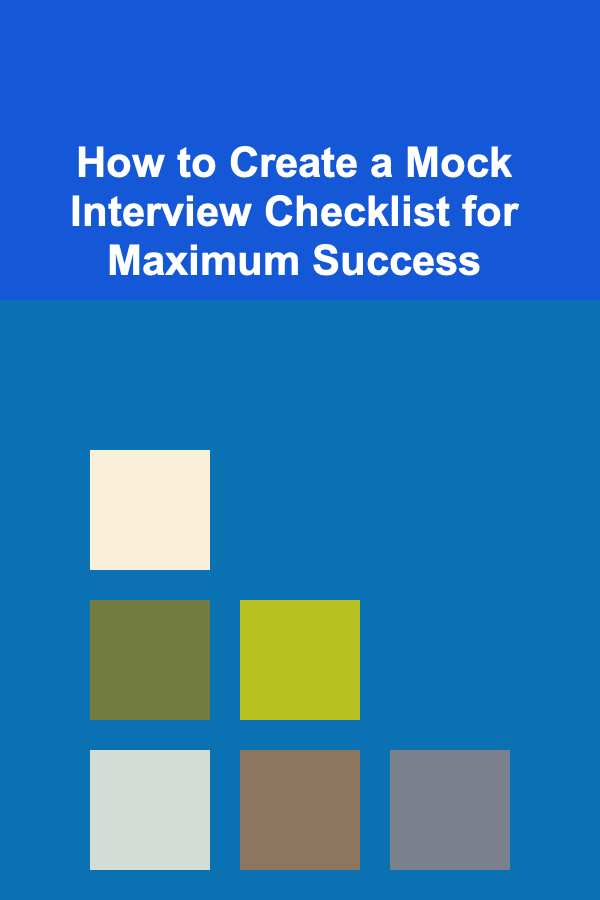
How to Create a Mock Interview Checklist for Maximum Success
ebook include PDF & Audio bundle (Micro Guide)
$12.99$10.99
Limited Time Offer! Order within the next:

Preparing for a job interview can be daunting, but with proper preparation and practice, you can significantly increase your chances of success. One effective way to prepare is by conducting mock interviews, which simulate the real interview experience and help you build confidence, improve your answers, and identify areas for improvement. However, to make the most out of a mock interview, it's essential to have a structured checklist that covers all the critical aspects of the interview process. In this article, we will discuss how to create a mock interview checklist that will ensure you're fully prepared for your next big interview.
The Importance of Mock Interviews
Before diving into the checklist, let's first understand the importance of mock interviews. A mock interview is essentially a practice run for the real interview. It can be conducted with a friend, mentor, or career coach, and its purpose is to simulate the pressure and structure of an actual interview setting. Mock interviews help you:
- Gain Confidence: The more you practice, the more comfortable you'll become with answering questions and presenting yourself in an interview setting.
- Identify Weaknesses: You'll be able to identify areas where you might struggle, whether it's answering a specific type of question or handling nervousness.
- Refine Your Responses: Through repeated practice, you can fine-tune your answers and delivery, ensuring that your responses are clear, concise, and effective.
- Improve Non-Verbal Communication: In addition to answering questions, mock interviews also allow you to practice your body language, eye contact, and tone of voice.
With these benefits in mind, let's dive into how you can create a mock interview checklist to maximize your success.
Creating the Mock Interview Checklist
To ensure that you are thoroughly prepared for your interview, it's crucial to create a checklist that covers every aspect of the mock interview process. Below, we'll break down the key components of this checklist.
Step 1: Define Your Interview Goals
Before scheduling your mock interview, it's essential to define the goals you hope to achieve through the practice session. By setting clear objectives, you can focus your efforts on areas that need the most attention.
- Goal Example 1: Improve my ability to answer behavioral interview questions.
- Goal Example 2: Practice answering technical questions related to the role.
- Goal Example 3: Increase comfort with handling situational and problem-solving questions.
Having specific goals in mind will allow you to tailor the mock interview to your needs and help you track your progress over time.
Step 2: Choose the Right Interviewer
Your mock interview can be conducted with anyone, but it's important to select someone who can provide constructive feedback. Here are some options:
- A Career Coach: A professional with expertise in interview preparation can provide valuable insights and personalized advice.
- A Mentor or Colleague: Someone who understands the industry and the role you're applying for can offer targeted feedback.
- A Friend or Family Member: If you don't have access to industry professionals, a supportive friend or family member can still be an excellent resource.
Choose an interviewer who will challenge you while also providing a comfortable environment for practice.
Step 3: Create a List of Common Interview Questions
Mock interviews are most effective when you simulate the types of questions you'll face in a real interview. While you can never predict every question, there are certain categories of questions that are commonly asked. These include:
-
General Questions:
- Tell me about yourself.
- Why do you want to work for this company?
- What are your strengths and weaknesses?
- Where do you see yourself in five years?
-
Behavioral Questions (based on the STAR method):
- Tell me about a time when you had to deal with a difficult situation.
- Give an example of when you worked successfully as part of a team.
- Describe a situation where you had to solve a problem under pressure.
-
Situational Questions:
- How would you handle a conflict with a colleague?
- If you were faced with a tight deadline, how would you prioritize your tasks?
-
Technical Questions (if applicable to the role):
- Walk me through how you would solve this technical problem.
- What is your experience with [specific tool or software]?
-
Questions Related to the Role/Company:
- What do you know about our company culture?
- How do you think your skills will contribute to the role?
Step 4: Develop Your Answers
For each of the common interview questions, develop and rehearse your answers. When responding to behavioral or situational questions, use the STAR method to structure your responses:
- Situation: Describe the context of the situation you were in.
- Task: Explain the task you needed to complete.
- Action: Discuss the actions you took to address the task.
- Result: Share the results of your actions, emphasizing any positive outcomes.
Additionally, make sure to:
- Tailor your answers: Customize your responses based on the job description, company, and industry.
- Be concise and focused: Avoid rambling, and ensure that your answers are to the point.
- Highlight your achievements: Whenever possible, share quantifiable results to demonstrate your impact.
Step 5: Prepare for Unexpected Questions
While it's important to prepare for common questions, it's equally essential to be ready for unexpected or curveball questions. These types of questions may test your creativity, problem-solving abilities, or how you handle pressure. Examples include:
- If you could have dinner with anyone, living or dead, who would it be and why?
- How would you explain a complex technical concept to a non-expert?
- What would you do if you were given a project with very little guidance?
While these questions might seem strange, they offer insight into your personality and problem-solving abilities. Practice answering these types of questions during your mock interview to increase your adaptability.
Step 6: Practice Your Non-Verbal Communication
In addition to preparing your answers, it's essential to focus on your non-verbal communication. Your body language, tone of voice, and eye contact can all influence the impression you make on the interviewer.
- Posture: Sit up straight and maintain good posture to convey confidence.
- Eye Contact: Make eye contact with the interviewer to show engagement and sincerity.
- Hand Gestures: Use natural hand gestures to emphasize points but avoid excessive or distracting movements.
- Facial Expressions: Ensure that your facial expressions match the tone of your conversation. Smile when appropriate and maintain a calm, approachable demeanor.
- Tone of Voice: Speak clearly, and adjust your tone to sound confident and enthusiastic.
Step 7: Dress the Part
Even though it's a mock interview, dress as you would for a real interview. Dressing appropriately for the interview helps put you in the right mindset and allows you to practice presenting yourself professionally.
- For Formal Interviews: Wear business attire such as a suit or business dress.
- For Casual Interviews: Choose business casual attire, such as a collared shirt and dress pants.
Ensure that your clothing is clean, well-fitting, and appropriate for the industry and company culture.
Step 8: Rehearse the Interview Environment
The mock interview environment should closely resemble the real interview setting. If possible, conduct the mock interview in a quiet room, free from distractions. Additionally, if your interview will be virtual, practice using the video conferencing platform (e.g., Zoom, Skype, Google Meet) beforehand to ensure everything works smoothly.
- Check Technology: Test your microphone, camera, and internet connection.
- Dress Professionally: Even in a virtual interview, dress as if you were meeting in person.
- Minimize Distractions: Close unnecessary tabs and mute notifications on your computer or phone.
Step 9: Evaluate Your Performance
After the mock interview, take the time to evaluate your performance. Ask your interviewer for constructive feedback on the following aspects:
- Your Answers: Did your responses demonstrate your qualifications? Were they clear and concise?
- Body Language: Did you maintain good posture, eye contact, and facial expressions?
- Tone of Voice: Did you sound confident and enthusiastic?
- Overall Impression: Did you leave a positive impression on the interviewer?
If possible, record the mock interview and review the footage to assess your performance objectively.
Step 10: Make Improvements
Based on the feedback you receive, identify areas where you can improve. Whether it's refining your answers, working on your body language, or practicing specific interview questions, take actionable steps to enhance your performance before the real interview.
Final Thoughts
Mock interviews are a powerful tool for interview preparation, allowing you to practice your answers, improve your confidence, and fine-tune your delivery. By following the checklist outlined above, you can ensure that you're well-prepared for any interview scenario. With repeated practice and continuous self-assessment, you'll be better equipped to make a strong impression on your next potential employer.
The key to success lies in consistent practice and self-reflection, and with a mock interview checklist, you can take your interview preparation to the next level.
Reading More From Our Other Websites
- [Ziplining Tip 101] How to Organize a Corporate Team‑Building Day on a Zipline Course
- [Organization Tip 101] How to Create a System for Storing Seasonal Decorations
- [Home Renovating 101] How to Plan a Sustainable Renovation for Your Home
- [Home Storage Solution 101] How to Utilize Furniture with Built-In Storage to Maximize Your Living Space
- [Home Party Planning 101] How to Send Paperless Party Invitations That Make a Statement
- [Organization Tip 101] How to Set Up a Study Zone with Minimal Distractions
- [Home Lighting 101] How to Illuminate Your Home for Better Curb Appeal
- [Personal Care Tips 101] How to Choose a Soap with Moisturizing Properties
- [Trail Running Tip 101] Best Trail Running Recovery Strategies: Muscle Soreness, Nutrition, and Mental Reset
- [Personal Care Tips 101] How to Choose a Facial Cleanser with No Harsh Chemicals

How to Design a Mudroom with Practical Storage Features
Read More
How to Use Art and Decor to Personalize Your Home Staging
Read More
How To Identify Chekhov's Gun in Movies
Read More
Exploring the World of the Scythians: A Journey Through History, Archaeology, and Culture
Read More
10 Tips for Predicting Tornadoes Using Doppler Radar
Read More
How to Build a Voice-Controlled Home Automation System with Arduino
Read MoreOther Products

How to Design a Mudroom with Practical Storage Features
Read More
How to Use Art and Decor to Personalize Your Home Staging
Read More
How To Identify Chekhov's Gun in Movies
Read More
Exploring the World of the Scythians: A Journey Through History, Archaeology, and Culture
Read More
10 Tips for Predicting Tornadoes Using Doppler Radar
Read More